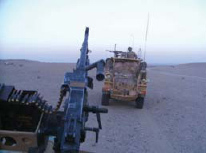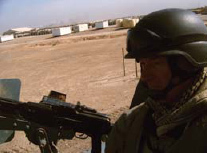The basic principles of getting a supply convoy safely from Point A to Point B haven’t fundamentally changed in 40 years. A supply convoy in Yemen during the counter-insurgency campaign in 1964. (Photo courtesy Colour Sergeant Trevor ‘Sadie’ Sadler, 1st Battalion ‘The Vikings’ Royal Anglian Regiment)
Anti-ambush drills are for when you have been unable to avoid being ambushed: the ambush has been sprung and people are shooting at you. They work when the ambush is either poorly organized or the intention is more to harass your people and make you run around than kill you all. This latter is often the case when insurgents don’t have the manpower or hardware to put on a proper show. Anti-ambush reaction drills do not work well when the ambush is set up right. Nothing does.

A British SF patrol in Jackals, Afghanistan 2010. (Photo courtesy Tom Blakey)
Avoidance is better than reaction
Whatever your strength and assets the best defence against an ambush is not to be caught in one because, generally, an ambush is sprung at the choice of the ambusher. This means the ambush is only triggered when the target force is either weak enough to kill or unable to chase down the group applying the harassing fire. You will always be at a disadvantage when ambushed. Your first consideration then is to organize your forces and movement to avoid an ambush. If your anti-ambush patrols catch an enemy force preparing an ambush for you then they are effectively assaulting them or ambushing them first. This is much better.

Always put a steady man on the back vehicle: former Para, Sergeant Roy Mobsby, PMC vehicle patrol in Iraq. (Photo courtesy Roy Mobsby)
Given you don’t come across the ambush before it is sprung then how you respond depends to a great extent on your forces and the type of ambush. I have tried to cover all the alternatives below to make this clear and get it to stick in your mind.
An ambush against your foot patrol
A close-range ambush is more serious as the choice to run away should have been eliminated in the planning by mining or covering the escape with effective fire. The only way to go is straight at the enemy. A determined charge, perhaps after setting up a fire team on your flank, will cause most ambushers to lose their nerve and run. Certainly this is better than the alternative – stay where you are in the area chosen by the enemy as the easiest killing ground.
REMEMBER:
The best anti-ambush drill by far is to avoid being caught in one.
An ambush against your vehicle patrol
Pretty much the same applies as for foot patrols with one or two significant differences:
Vehicle patrols tend to carry heavier weapons than foot patrols and be armoured to some extent. This means that an ambush will almost always be triggered by a mine or IED and then, rather than make the effort to kill you, the ambushers will very often fire with RPGs or heavy machine guns from a distance in the hope of penetrating your armour and increasing the casualties without too much risk. An RPG has a range of 1,100m and a .50cal machine gun double that so very often a small ambush party will stop you with a bomb and then fire at you with a heavy machine gun from over a kilometre away up a seriously steep hill. The best way to avoid a vehicle ambush other than the use of drones is anti-IED measures.
Protecting a supply convoy
Where you totally control an area there is going to be safe passage for your troops and vehicles. Where the enemy control the area you aren’t going to be sending supply convoys through, you are going to be attacking the enemy. The time that a protected convoy is used, and is at risk, is when you are occupying an area but the enemy are still present in sufficient numbers to potentially mount an ambush.
By its very nature a convoy of trucks is something of an easy target for an insurgent attack. Trucks have to follow recognized roads and sooner or later you have to move your people, equipment or whatever. Moving everything by air is expensive, slow to move bulk and ties up air-assets – in the end you really need to use trucks even though they are not heavily armoured. So – in principle – all the insurgent has to do is sit by the road.
In addition, following a road – which may wind through difficult and mountainous country – means the convoy is difficult to protect. It is a thin line of firepower at best and the enemy can concentrate his forces at a point ideally suited to his needs. This makes it relatively easy, in the ordinary way of things, to create a localized superiority of firepower in favour of the attacker.